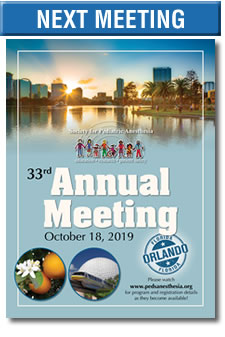Update on the Section on Anesthesiology, the American Academy of Pediatrics
By Anita Honkanen, MD
Section Chair Elect
Our nation is facing many difficult challenges. Challenges that have impacted the health of children in substantial ways. From deaths due to gun violence, opioid use, dental sedation, incarceration at our borders, or lack of immunizations, the threats to the most vulnerable seem to be multiplying. As we grapple as a nation with so many complex challenges, the issues endangering our children require the experience, expertise, talents, and commitment of our physicians to be sure they are not forgotten, lost in the noise of the multitude of concerns being faced. I am proud to say that committed members of the AAP and SOA have been working on many fronts to this end.
Whether it’s education and advocacy related to pain control for children and the proper use and disposal of opioids, or sustained efforts of SOA members to refuse to let deaths of healthy children undergoing dental procedures go unnoticed, developing guidelines to clearly communicate what is needed for safe sedation, the SOA is making an impact. And the AAP and SOA members continue to advocate strongly in Washington and at the state level for sensible restrictions on firearms, to educate our nation’s lawmakers and populace about the importance of immunizations, to push for safe sedation in dentistry, and to bring a spotlight on the terrible impacts of separating immigrant children from their parents and adult family members.
In these ways, and so many more, the AAP and SOA are making sure the needs of our children remain at the center of our consciousness. For it is time to stand with conviction for what is right: safeguarding our children.
Guidelines for Monitoring and Management of Pediatric Patients Before, During, and After Sedation for Diagnostic and Therapeutic Procedures
-
The SOA had substantial input into the revised AAP/American Academy of Pediatric Dentistry clinical report, published in the June 2019 issue of Pediatrics (May 28 online). The guidelines recommend that at least two people with specific training and credentials should be present with a pediatric patient undergoing deep sedation or general anesthesia for dental treatment in a dental facility or hospital. The report also clarifies that the sedation should be administered by a qualified anesthesia provider, defined in the guideline as including medical anesthesiologists, certified registered nurse anesthetists, dentist anesthesiologists or a second oral surgeon. Under the 2019 guidelines, one of the two trained people required for sedation must be an independent observer who is not involved with performing or assisting with the dental procedure. The observer’s sole responsibility is to constantly observe the patient’s vital signs and to he/she must be skilled to assist with any medical emergency. And both the independent observer and the operating dentist must be certified in Pediatric Advanced Life Support. The full report is available online at: https://pediatrics.aappublications.org/content/early/2019/05/24/peds.2019-1000
Pediatrics for the 21st Century (Peds-21)
-
The AAP Section on Anesthesiology and Pain Medicine (SOA) has been given an amazing opportunity to host a one-day educational session at the 2019 AAP National Conference and Exhibition. This annual AAP pre-conference, titled Pediatrics for the 21st Century (Peds-21), focuses on one chosen topic, something that is currently impacting the practice of pediatrics in a major way. AAP Sections, Councils, and Committees submit applications to have the chance to sponsor the meeting on a topic of their choice, a process that has become quite competitive over the years; for 2019, the SOA proposal was accepted. This year’s Peds-21 session will be titled, “Opioids Through the Ages – Caring for Children and Families in the Wake of the Opioid Crisis.” The AAP National Conference draws in about 12,000 attendees annually, and Peds-21 typically has an attendance of about 1000. The Peds-21 meeting this year will take place on Friday, October 25th, and the conference schedule can be viewed at: https://aapexperience.org/peds-21/
2019 AAP National Conference presentations, October 25-29
- The Section on Anesthesiology and Pain Medicine with other AAP Sections will offer two joint programs at the 2019 AAP National Conference to help educate pediatricians in methods of effective pain management that minimize the use of opioids:
- “Integrative Approaches to Pain: non-pharmacologic, Non-Invasive Options Amid the Opioid Crisis” with the Section on Integrative Medicine and the Section on International Child Health and
- “Pediatric Pain Management for Hospitalists: A Life Course Perspective” with the Section on Hospital Medicine.
Statements in Progress
The SOA has multiple statements in progress, focused on creating guidance for practitioners in a variety of situations. These include the following:
- The Assessment and Management of Acute Pain in Infants, Children, and Adolescents: offering concrete approaches to treatment of pain in pediatrics.
- Chronic Pain in Infants, Children, and Adolescents: a wide-ranging overview of the issues in diagnosis and treatment for this under-appreciated problem.
- Perioperative Management of the Child with OSA: focused on creating guidelines for practitioners caring for children with OSA coming for any type of procedure under anesthesia.
- Oxymetazoline (Afrin®): Considerations for Pediatric Use: developing material to ensure the risks and dosing of Afrin are well understood for a variety of situations.
- Oral Health for Children with Disabilities (Section on Oral Health): a joint effort to highlight the importance of and difficulties with maintenance of adequate oral health for children with disabilities.
- Preoperative Clearance in the Pediatric Patient with Congenital Heart Disease: educational guidelines to ensure practitioners know key preparation needed for children with CHD prior to anesthesia and surgery.
- Guidelines for Monitoring and Management of Pediatric Patients During and After Sedation for Diagnostic and Therapeutic Procedures: brings the latest knowledge from the literature to refresh current guidelines.
Development of Pediatric Pain Trans-disciplinary Fellowship
-
Nationwide a deficit in the number of trained pediatric pain practitioners exists: pain in children is both under-recognized and undertreated. The AAP SOA, SPPM, SPA, and the AAP Section on Neurology are partnering to focus on development of an independent accredited fellowship in Pediatric Pain Management that will train pediatric practitioners, from a variety of specialties where children-in-pain commonly present.
Children’s Surgery Subcommittee of the Section on International Child Health
-
The AAP Section on International Child Health has recently established a Children’s Surgery Subcommittee, which includes liaisons from the Section on Anesthesiology and Pain Medicine. The purpose of this new entity is to bring together children’s surgery providers in the US who are engaged in international work in low and middle income countries. This group is multidisciplinary with the goal of including all specialties concerned with the surgical care of children: anesthesia, surgical specialties (pediatric general surgery, orthopedics, plastics, neurosurgery, etc.), radiology and others. It has created a forum for sharing collective experiences for approaches and programs that have worked within certain specialties, and challenges and opportunities therein. The Subcommittee hopes to leverage the prominent role that the AAP plays in international advocacy for children to increase awareness of children’s surgical issues and identify points of collaboration between pediatricians, allied health professionals and their global surgical colleagues.
AAP Academic and Subspecialty Advocacy Washington Report
-
The March 2019 AAP Academic and Subspecialty Advocacy Washington Report is available here. The report contains a special message from AAP President, Dr. Kyle Yasuda, and details the important advocacy work that the AAP is engaging in, highlighting issues of particular importance to medical and surgical subspecialty pediatricians. The report includes updates on AAP advocacy efforts to support Medicaid, prevent firearm-related injury and death, protect immigrant children, promote pediatric subspecialty workforce issues, stimulate access to safe and effective drugs and medical and surgical devices for children, and increase funding for pediatric research, among many other issues. A recent AAP News article of interest highlights 2018 AAP accomplishments in child advocacy.
-
The AAP has also recently announced the release of an AAP Subspecialty Advocacy Toolkit. This toolkit provides information on ways for subspecialists to engage in advocacy across all levels of government with the support of the AAP’s advocacy team.
Spring Newsletter
-
Link to Spring 2019 AAP Section on Anesthesiology and Pain Medicine newsletter: https://downloads.aap.org/DOSP/SOASpringNewsletter2019.pdf






